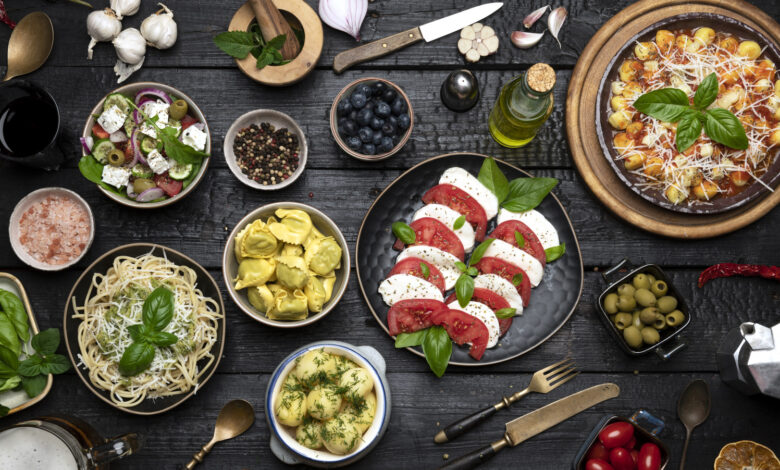9 dishes worth trying in Italy, besides pizza and pasta

Arrosticini, Abruzzo
Abruzzo is a mountainous region where sheep have been raised for a long time. It is not surprising that the signature dish here is lamb, or more precisely, a special kebab called arrosticini. Small pieces of fresh meat (about 1×1 centimeter) are strung on wooden skewers and quickly fried on the grill. It is not customary to marinate lamb – it is believed that it is quite aromatic and without spices.
Abruzzian supermarkets sell packages of ready-to-fry kebabs (lamb is cut into small cubes using special machines). All you have to do is light the grill – and in a few minutes you can eat arrosticini directly from the skewers. Pieces of meat that melt in the mouth are usually eaten with fresh bread, dipped in olive oil, and washed down with the main wine of the region – Montepulciano d’Abruzzo.
Artichokes (carciofi), Rome
Although artichokes are prepared throughout Italy, they are most skillfully handled in Roman kitchens. One of the traditional recipes is called Roman artichokes: peeled “flowers” are boiled with garlic, aromatic herbs and white wine.
The second popular recipe is Jewish-style artichokes: they are deep-fried with salt and pepper. For this option, you should definitely go to the restaurants of the Jewish ghetto of Rome. The main thing is to remember that the season for this artichoke is from November to April, and there is no point in looking for them on the summer menu.
Florentine steak (bistecca fiorentina), Tuscany

One of the most coveted Italian dishes for meat eaters. To earn the right to be called a Florentine steak, the meat must come from Chianina cows and be cut from the lower back with a piece of the T-bone. Italian steak is distinguished from its American “brothers” – T-bone and porterhouse – by its solid thickness, about 5-6 centimeters.
However, culinary specialists admit that now these requirements are not always adhered to. Marketing has done its job – tourists themselves line up to pay from 40 to 60 euros per kilogram of meat. And nothing bad will happen if you use regular beef rather than chianina, and cut the steaks not only from the loin, but also from another part of the carcass.
One thing remains unchanged. Before cooking, the meat is kept for at least two weeks, and then fried over coals until rare or medium rare. Spices are not used so as not to spoil the taste: salt, pepper and olive oil are served with the finished dish. A standard portion is about 1 kilogram, so steak is usually taken for at least two people. Some of the most popular in Tuscany are the restaurants of butcher Dario Cecchini, where they make a real show of serving steak.
Cannoli, Sicily
Yes, cannoli are now sold in every second coffee shop far outside Italy. But those with a sweet tooth say that this dessert should be eaten in its homeland – Sicily. According to legend, nuns from Palermo began deep-frying the dough tubes and filling them with ricotta. At first, cannoli was baked only during carnivals, but the dish turned out to be so tasty that it became part of the everyday menu.
In Italy, cannoli are made in different sizes: from bite-sized tubes for a sip of espresso to giants that barely fit in your hand. Nuts, candied fruits, chocolate, mascarpone, liqueurs and Marsala (Sicilian dessert wine) are added to the filling. The main rule is to eat the cannoli fresh, otherwise the tube, soggy from the cream, will not crunch.
Oxtail stew (coda alla vaccinara), Rome
Roman poor people’s cuisine is famous for its offal dishes. In the Italian capital, tripe, heart, intestines, spleen and other unattractive (at first glance) parts of the carcass are skillfully prepared. But the king of folk dishes is considered to be oxtail stew.

Once upon a time, meat slaughterhouse workers in the Testaccio area were given the so-called fifth quarter of a cow – the parts that were not sold. It turned out that the tails are not only suitable for eating: they make a hearty and tasty dish if you simmer the meat over low heat for at least four hours with the addition of vegetables and tomato sauce.
Oxtail stew can now be found on the menu of many Roman restaurants, especially in the popular districts of Testaccio and Trastevere. Despite the not-so-Instagrammable appearance of the dish, the flavorful meat melts in your mouth, and one serving can probably fill you up for the whole day.
Ossobuco, Lombardy
A classic of Milanese cuisine is stewed beef shank with marrow bone (osso – “bone”, buco – “hole”). In the original version, shank steaks were stewed in white wine and with herbs and garlic. When tomatoes appeared in Italy, the recipe was changed. Nowadays, meat is most often cooked on a bed of vegetables with the addition of tomato sauce.
The obligatory final chord is to eat the bone marrow in order to leave in the bone the very hole that gives the dish its name.
Ascolana olives (olive all’ascolana), Marche
One of the gastronomic attractions of the Marche seaside region is the giant olives from the province of Ascoli Piceno. They are stuffed with meat, breaded in breadcrumbs and deep-fried.
It is believed that this recipe was invented in the 19th century by chefs of the local nobility, who were looking for a recipe for disposing of leftover meat after feasts. The Askolans liked the idea. Nowadays, a hearty and inexpensive snack can be found in almost any cafe or gastronomy in Ascoli Piceno.


